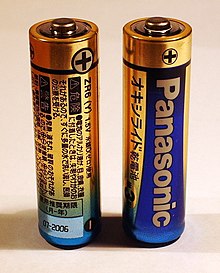Nickel oxyhydroxide battery
The nickel-oxyhydroxide battery (NiOx battery) is a galvanic cell belonging to the primary elements, i.e. a non-rechargeable battery . It was first presented to the public in April 2004 by the manufacturer Panasonic under the name OxyRide . Corresponding batteries are now also being offered by other manufacturers.
The advantage of the nickel-oxyhydroxide battery over z. B. an alkaline-manganese battery lies in the typically more even power output over the entire, also significantly longer service life, which is about 1.5 to 2 times as high as that of an alkaline-manganese battery. Another advantage is its high current capability, which makes it suitable for more powerful consumers such as small electric motors .
The material for the cathode , nickel oxyhydroxide, was newly developed . A " Tablet Mix Control System " also controls and optimizes the proportions of nickel oxyhydroxide, manganese dioxide and graphite for the entire cell. In addition, a new vacuum casting technology ensures that a larger amount of electrolyte can be absorbed by the battery.
A disadvantage is their cell voltage of 1.7 V instead of 1.5 V as in an alkaline manganese battery, which means that some devices that do not perform voltage regulation can be damaged by it. Commercially available cells are Mignon (AA) and Micro (AAA) types .
Individual evidence
- ↑ Katerina E. Aifantis, Stephen Andrew Hackney, Stephen A. Hackney, R. Vasant Kumar: High Energy Density Lithium Batteries: Materials, Engineering, Applications . Wiley-VCH, 2010, ISBN 3-527-32407-0 , pp. 49 .

